Songs and stories in Scotland
12/05/2017 - blog
Here’s my first report of what it was a fantastic cultural immersion and experience in the Scottish Lowlands. To all my English readers, sorry for my mistakes in writing English, I will be very grateful if you inform me about any errors. Thank you very much to Pete Heywood for his fantastic black and white pictures!
Friday, 27th April
I fly from Barcelona to Heathrow and from there to Glasgow, landing in the Scottish lowlands, where Colin McAllister. He is an Irish storyteller and singer based in Scotland that I met at Baltica Festival 2015 in Latvia, and since then we have been exchanging views about stories, music and oral tradition. We go to Douglas, were he lives with his wife Marion, and on the way we catch up with what has happened to us since the last time we met in Barcelona, and as the city is changing to an unbelievable green, we listen kannele music, an Estonian instrument, brother of the Latvian kokle; its magic and delicate sound blends very well with this landscape, and we talk about one of the topics that fascinates us: the fusion of cultures and the existing connections between people from distant places.
As Colin stops for a message, I look the case of the CD we are listening to: Trio Soon/Piho/Lepasson – Tempo di Vals. In the back cover, these three kannele virtuosi say: “We play kannel, an instrument that has been played by many generations before us. Our music is inspired by Estonian folk melodies. It sprouts from archive recordings, as well as from small motives that ran out our fingers and little ideas that got wings. This is our first CD. A testimony of our journey so far.” I like this image of the motives running out of their fingers, because it is something that I am enjoying right now with my first and clumsy steps with the kokle. And I like to imagine art as a journey, and all that you meet on the way becomes part of you and of what you do.
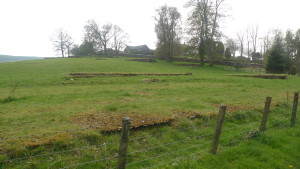 From time to time Colin shows me elements from the landscape, telling me its story, and we also talk about folklore issues, and his words reminded me something I was just reading on the plane, on an article of Josep Mª Pujol in English (Three Selected Papers on Catalan Folklore): that folklore is not the text, but the context. In other words, the event, what happens when a group comes together. So I intend to be aware of what will happen around me from now on.
From time to time Colin shows me elements from the landscape, telling me its story, and we also talk about folklore issues, and his words reminded me something I was just reading on the plane, on an article of Josep Mª Pujol in English (Three Selected Papers on Catalan Folklore): that folklore is not the text, but the context. In other words, the event, what happens when a group comes together. So I intend to be aware of what will happen around me from now on.
And it seems that here, the Scots they know how to come together and organize things: tomorrow I will participate at the Girvan Traditional Folk Festival, that celebrates its 43rd anniversary this year, and it is also one of the few folk festivals where storytelling is an important part of its programme. Three intensive days: on Friday, concerts, on Saturday, workshops, and on Sunday, stories. Colin has only missed once this annual event, and the festival is a sort of meeting point for all folklore lovers.
We are in Lanarkshire, one of the historic shires of the Scottish lowlands, full of soft hills. Some hills excel among others, either by height or by history, like the Tintock or Tinto hill, where they say that the famous Scottish hero Sir William Wallace made a hole in the upper side with the grasp of his thumb. And as I have told Collin that very recently I am including Catalan tongue twisters and riddles at the end of my storytelling sessions, he challenges me with a tongue twister very famous among Scottish children:
On Tintock-tap there is a mist,
And in that mist there is a kist [chest]
And in the kist there is a caup [cup]
And in the caup there is a drap [drop]
Tak up the caup, drink aff the drap,
And set the caup on Tintock-tap.
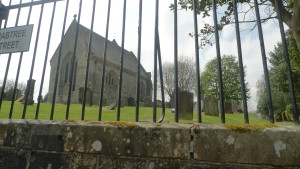 And so, training my poor Scots, we arrive to Douglas, a mysterious town with a little church (later I will discover that it is not a church, but Saint Bridget’s chapel, but it WAS a church, and very big, indeed), and a graveyard with a very special magic. “Of course it has a story, but I will tell it to you when we come back from the festival”, says Colin, who knows how to keep up a mystery and to wait for the right moment to reveal it.
And so, training my poor Scots, we arrive to Douglas, a mysterious town with a little church (later I will discover that it is not a church, but Saint Bridget’s chapel, but it WAS a church, and very big, indeed), and a graveyard with a very special magic. “Of course it has a story, but I will tell it to you when we come back from the festival”, says Colin, who knows how to keep up a mystery and to wait for the right moment to reveal it.
Marion is waiting for us at home, a cosy cottage house full of books and teapots and pictures and thousand and one souvenirs… Maybe because I have seen recently the films of The Hobbit, or maybe due to the quiet, golden light that crosses the curtains of the sitting room window, almost at street ground level, it reminds me a little Bilbo Baggins’s home. And after
having supper and chatting by the fireside, and after some stories too, of course, as every single object in the house is like a string that leads to a story, we go to bed, because tomorrow we will leave for Girvan after breakfast.
Saturday, 28th April
 The following morning, after the second breakfast (the first, a typical Scottish breakfast, with eggs and bacon; the second one, tea with snowballs, a popular cake in this region) we cross the Douglas valley and head for the coast. Deep green grasslands scattered with sheep and lambs (it is breeding season) is the dominant landscape.
The following morning, after the second breakfast (the first, a typical Scottish breakfast, with eggs and bacon; the second one, tea with snowballs, a popular cake in this region) we cross the Douglas valley and head for the coast. Deep green grasslands scattered with sheep and lambs (it is breeding season) is the dominant landscape.
 From time to time, the silhouette of trees stand out in the horizon: many of them have not yet sprouted; spring seems to come a bit later here than in Barcelona. The road crosses little towns, and the ruins of a castle or an abbey remind us ancient times, or not so ancient: the Barony A frame near Auchinleck in the distance is a testimony of the time when this region was famous for its mines and blast furnaces, not so long ago.
From time to time, the silhouette of trees stand out in the horizon: many of them have not yet sprouted; spring seems to come a bit later here than in Barcelona. The road crosses little towns, and the ruins of a castle or an abbey remind us ancient times, or not so ancient: the Barony A frame near Auchinleck in the distance is a testimony of the time when this region was famous for its mines and blast furnaces, not so long ago.
We cross the Doon river and we drive near Alloway, Robert Burns’ hometown, and although today is sunny and the sky is clear, I cannot help to imagine Tam O’Shanter galloping in his horse, pursued by the witches, in this very place, but at night and in the mist.
 And then, past the potato fields and the grasslands with caws, we see the seaside, and there, really close, as a giant putting his head out of the water, we can see Aisla Craig, and it won’t cease to watch us until we arrive to Girvan. The town is really quiet in this time of the year: in the summer is more livelier, many people of Glasgow come here to walk along the beach and have an ice cream. It is also not far from the point where the ferries arrive from Ireland: “If you throw a stone from here, you can hit Ireland”, says Colin. He is now very close to his beloved native land: County Antrim.
And then, past the potato fields and the grasslands with caws, we see the seaside, and there, really close, as a giant putting his head out of the water, we can see Aisla Craig, and it won’t cease to watch us until we arrive to Girvan. The town is really quiet in this time of the year: in the summer is more livelier, many people of Glasgow come here to walk along the beach and have an ice cream. It is also not far from the point where the ferries arrive from Ireland: “If you throw a stone from here, you can hit Ireland”, says Colin. He is now very close to his beloved native land: County Antrim.
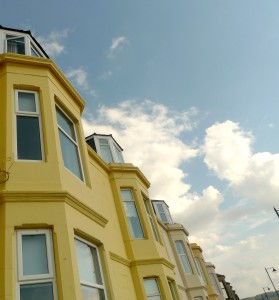 We go to the Westcliffe Hotel, an elegant building at the waterfront, that seems to be the festival’s head office, just a stone’s throw away from our bed and breakfast, but it takes us quite long to reach it: at every turn Colin and Marion meet friends to greet and talk to. I am fascinated by the different accents of melodies I hear from the different regions of Scotland or Ireland they come from. Sometimes it is difficult for me to understand them, but they make an effort to speak slowly when they speak to me, and I feel very welcomed for this. After greeting Maggie Macrae, the festival’s director, that is working hard with all her team to make everything ready, and receiving our programme and some practical details, it is almost five thirty, so we go to Steven and Sharon’s bed and breakfast.
We go to the Westcliffe Hotel, an elegant building at the waterfront, that seems to be the festival’s head office, just a stone’s throw away from our bed and breakfast, but it takes us quite long to reach it: at every turn Colin and Marion meet friends to greet and talk to. I am fascinated by the different accents of melodies I hear from the different regions of Scotland or Ireland they come from. Sometimes it is difficult for me to understand them, but they make an effort to speak slowly when they speak to me, and I feel very welcomed for this. After greeting Maggie Macrae, the festival’s director, that is working hard with all her team to make everything ready, and receiving our programme and some practical details, it is almost five thirty, so we go to Steven and Sharon’s bed and breakfast.
 Colin and Marion have been staying for 20 years when they come to the festival, so they are almost family. Steven is fisherman and also chef, like Sharon, and they serve us a fantastic meal: fish and chips (the first time in my life I try this classic!), cheesecake, and of course, a cup of tea, because this is how they call here dinner, and I learn the difference between “Come and have a cup of tea” and “Come and have your tea”.
Colin and Marion have been staying for 20 years when they come to the festival, so they are almost family. Steven is fisherman and also chef, like Sharon, and they serve us a fantastic meal: fish and chips (the first time in my life I try this classic!), cheesecake, and of course, a cup of tea, because this is how they call here dinner, and I learn the difference between “Come and have a cup of tea” and “Come and have your tea”.
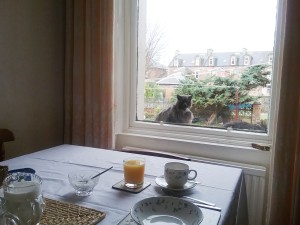
After tea we go to rest a bit until the time to go to the opening concert: I really feel honoured of being asked to participate, but I am a bit nervous, too. I am not a singer, but a storyteller, and they know it, but as I use to sing songs in my storytelling, and they insisted in listening some songs in Catalan, I have brought a mixture of both things: I will tell them the story of different Catalan songs and sing them as well. But I have my doubts. They will understand my English? I will understand them if they tell me something? It is the first time I am telling in English in front of an audience with English as a mother tongue.
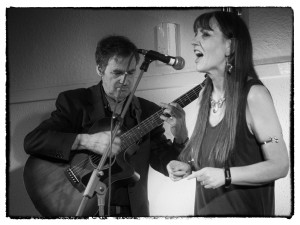 Again to Westcliffe Hotel: the ground floor is divided in a bar and several carpeted rooms with sofas and chairs and wee tables, like traditional pubs. The main room is full of rows of chairs for the concert, that begins promptly: Colin introduces Sylvia Barnes and Sandy Stanage, one of the most famous folk music duets in Scotland. I love Sylvia’s voice and expression, and I notice that many people knows the songs and sings with her. Many are ballads with a tragic end, and they tell me that there are not many Scottish ballads with a happy end. Each song is a story, the boundary between story and song seems very dim here.
Again to Westcliffe Hotel: the ground floor is divided in a bar and several carpeted rooms with sofas and chairs and wee tables, like traditional pubs. The main room is full of rows of chairs for the concert, that begins promptly: Colin introduces Sylvia Barnes and Sandy Stanage, one of the most famous folk music duets in Scotland. I love Sylvia’s voice and expression, and I notice that many people knows the songs and sings with her. Many are ballads with a tragic end, and they tell me that there are not many Scottish ballads with a happy end. Each song is a story, the boundary between story and song seems very dim here.
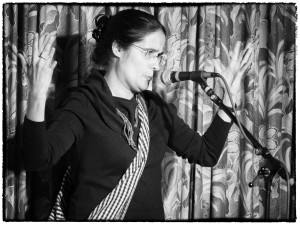 I feel more relaxed when my turn comes: I have become aware that I am not in front of a monolingual audience. Scots, Gaelic, English… I am not in a strange land in terms of linguistic environment. And as I have seen the people’s willingness to sing along, I begin a corranda, that is, an improvised song of my region, with the first stanza dedicated to the festival, and I invited them to sing along a chorus without words, the one my grandfather liked to sing. And they join in immediately. It works, so I go on telling about different contexts: the aplecs (festival gatherings where people used to dance) with the song La flor de Vilabertran (The Flower of Vilabertran), and they even dare to sing a chorus in Catalan. I also tell them the gruesome story of L’Hostal de la Peira (The Peira’s Inn), and the relationship of this song with my grandmother, and they help me with the “Olá” in the sung part. I am enjoying so much that time goes by without noticing, and it is time to finish, so I close with El mariner (The Sailor), one of the most famous and beloved songs in Catalonia, and according to folklorist Joan Amades, was sung for fixing fishing nets. And I am just wearing a necklace that I weaved thanks to the workshop of weaving fishing nets within the project Anem a fer xarxa! in our Catalan Storytelling Association ANIN. I show them the necklace, saying that many songs and stories have disappeared probably because we don’t come together to do things as before, at least where I come from, because it seems to me that here, in Girvan, folksongs are very much alive today.
I feel more relaxed when my turn comes: I have become aware that I am not in front of a monolingual audience. Scots, Gaelic, English… I am not in a strange land in terms of linguistic environment. And as I have seen the people’s willingness to sing along, I begin a corranda, that is, an improvised song of my region, with the first stanza dedicated to the festival, and I invited them to sing along a chorus without words, the one my grandfather liked to sing. And they join in immediately. It works, so I go on telling about different contexts: the aplecs (festival gatherings where people used to dance) with the song La flor de Vilabertran (The Flower of Vilabertran), and they even dare to sing a chorus in Catalan. I also tell them the gruesome story of L’Hostal de la Peira (The Peira’s Inn), and the relationship of this song with my grandmother, and they help me with the “Olá” in the sung part. I am enjoying so much that time goes by without noticing, and it is time to finish, so I close with El mariner (The Sailor), one of the most famous and beloved songs in Catalonia, and according to folklorist Joan Amades, was sung for fixing fishing nets. And I am just wearing a necklace that I weaved thanks to the workshop of weaving fishing nets within the project Anem a fer xarxa! in our Catalan Storytelling Association ANIN. I show them the necklace, saying that many songs and stories have disappeared probably because we don’t come together to do things as before, at least where I come from, because it seems to me that here, in Girvan, folksongs are very much alive today.
 The concert goes on with Steve Turner and his concertina, and he continues with working songs about sailors, beginning with a whaling song. I have noticed that it seems to exist here a kind of pact between the audience and the artist: they have a special talent for interacting with comments or wordplays thrown by the artist and thrown back by the audience, answering or following them, but not intending to steal the limelight. They are just quick and accurate interventions that seem a sort of code to let the artist know that we are there with him, that we are all in the same boat. It is a pity that most of the comments are too quick for me, but I am happy of being able to understand some of them at least. Maybe I am beginning to get used to this variety of accents, the experience is being a true language immersion for me.
The concert goes on with Steve Turner and his concertina, and he continues with working songs about sailors, beginning with a whaling song. I have noticed that it seems to exist here a kind of pact between the audience and the artist: they have a special talent for interacting with comments or wordplays thrown by the artist and thrown back by the audience, answering or following them, but not intending to steal the limelight. They are just quick and accurate interventions that seem a sort of code to let the artist know that we are there with him, that we are all in the same boat. It is a pity that most of the comments are too quick for me, but I am happy of being able to understand some of them at least. Maybe I am beginning to get used to this variety of accents, the experience is being a true language immersion for me.
After the concert we go to buy some drinks and in the bar, people come up to me to talk and thank me for the songs. I take the opportunity for researching about the sailor song I sung, because in the songbook collected by Joan Amades, he literally says (in Catalan, of course): “Sung in the coast of Scotland with the same melody that is typical from Catalonia”. Here you find people of all corners of Scotland, but nobody seems to know neither the text nor the melody, but they are not surprised at all of the English king going to kidnap maids in the Catalan coast.
We go afterwards to the Catholic Hall, just a stone’s throw away (everything seems to be a stone’s throw away here), were a Late Singaround is taking place, that is, in Scots “a sang frae a’body and turns frae”. It is tradition here to sit down in a circle and sing in turns, and everybody is welcome to sing. But this time they have scattered tables and chairs around the room to make it in a more relaxed way: other concerts are taking place in different pubs, so it will be a quiet session: I guess the number of musicians per square metre in town is really high right now.
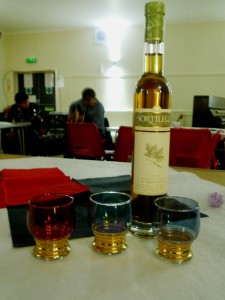 Colin and Marion know that I don’t drink very much, but I like sweet things, so they invite me to something especial: a Canadian whisky with maple syrup that Colin had as a present in his birthday, so we sit and toast and I must admit that it is good. Very good, indeed. Thank goodness Canada is far away, or I will be tempted more than one time.
Colin and Marion know that I don’t drink very much, but I like sweet things, so they invite me to something especial: a Canadian whisky with maple syrup that Colin had as a present in his birthday, so we sit and toast and I must admit that it is good. Very good, indeed. Thank goodness Canada is far away, or I will be tempted more than one time.
The singaround begins, first with some instrumental songs, marches and dances by virtuosi musicians, and then the people sitting around the tables begin to sing. The traditional style is a cappella singing, but in some special occasions musical accompaniment is agreed. Listening the people singing I become aware of being surrounded by great voices. If I had known that there were so many professional singers I wouldn’t dare to sing, but I feel so welcomed and also see that what it counts it is not to be professional singer or not, but to sing together, that I sing. And I listen, too: a girl’s lament for the men who are sent to the war in Spain, ballads of love and war, of migrant’s homesickness, of historical characters; songs about rows between man and wife, or in tribute to the traveller people and their nomadic life… Traditional melodies from Scotland or Ireland, or songs that went and came back from America. Some songs are really old, others not that much, but everybody seems to know them, so they are already part of the traditional repertoire. Many people has learnt new songs in this shared singing circles. You fell in love with a song, you learn it and you incorporate it in your repertoire, sometimes adding a slight variation, sometimes adapting it to your language or dialect or even your context. I love this way of sharing stories or songs, I think it is a very healthy way of keeping oral heritage alive and lively.
Among other singers (this is the list that appears on the programme, but many more sung too), I was fortunate to listen to Kathy Hobkirk, Francy Devine, Chris Miles & Gary Matthews, Rosie Lindsay and Adam McCulloch.
The singaround finishes. It is late, but many people goes now to the pubs, to go on the session until late into the night, or into the day. I have a workshop tomorrow morning, so at a quiet decent time I go back home (I feel very much at home) with Colin and Marion, with a chorus still in my lips: dolly dilly dum dilly dum dum day…

Leave a Reply